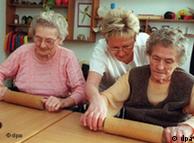placebo effect Stories in the Service of Making a Better Doctor

Aaron Houston for The New York Times
Tia Harmon, a patient at Saint Barnabas Medical Center in Livingston, N.J., listens as Dr. Benjamin Kaplan reads from "Kitchen Table Wisdom: Stories That Heal," by Dr. Rachel Naomi Remen.
By PAULINE W. CHEN, M.D.
Published: October 23, 2008
The white-coated crowd with stethoscopes slung casually around their necks would have looked familiar to anyone who has attended morning hospital rounds. Resident physicians and medical students milled about, chatting animatedly, and at the appointed hour, the attending physician signaled to begin.
But instead of filing toward a patient’s room, the group at Saint Barnabas Medical Center in Livingston, N.J., settled into a conference room at the end of the hall, not to recite details of patient cases but to read “Empty Pockets,” a personal essay by Dr. Kevan Pickrel from The Annals of Internal Medicine. In the piece, Dr. Pickrel describes being unable to save a 36-year-old woman, then going to the waiting room to inform the woman’s family of her death:
“The youngest daughter sat on Dad’s lap looking at pictures in an outdoors magazine. The older sat watching her hands rest in her lap. [The] husband’s eyes lifted to me and met mine. I didn’t, couldn’t, say a word.... He turned back toward his daughters, a single father, and they lifted their eyes to his. As he drew a breath to begin, his eldest daughter knew.”
After the reading, the attending physician, Dr. Sunil Sapra, looked up at the group assembled. “Do you identify with any of these situations?” he asked.
“Yes, it happens all the time,” a resident responded immediately. Others nodded in agreement, and one resident flicked a tear away.
The next morning, in a similar room at New York-Presbyterian Hospital in upper Manhattan, a group of obstetrics and gynecology residents gathered to read E.B. White’s short story “The Second Tree From the Corner.” Told from the perspective of an anxiety-ridden patient, the story ends with the main character finding meaning in his life and suddenly feeling liberated:
“He felt content to be sick, unembarrassed at being afraid; and in the jungle of his fear he glimpsed (as he had so often glimpsed them before) the flashy tail feathers of the bird courage.”
As the reading ended, one of the young doctors commented on how personally fulfilling it was to help her patients and how those feelings invigorated her, even after many hours of work. Other doctors in the room nodded in agreement.
While it has long been understood that clinical practice influenced the youthful writing of doctor-authors like Chekhov and William Carlos Williams, there is now emerging evidence that exposure to literature and writing during residency training can influence how young doctors approach their clinical work. By bringing short stories, poems and essays into hospital wards and medical schools, educators hope to encourage fresh thinking and help break down the wall between doctors and patients.
“We’re teaching the humanities to our residents, and it’s making them better doctors,” said Dr. Richard Panush, a rheumatologist and chairman of the department of medicine at Saint Barnabas.
The idea of combining literature and medicine — or narrative medicine as it is sometimes called — has played a part in medical education for over 40 years. Studies have repeatedly shown that such literary training can strengthen and support the compassionate instincts of doctors.
Dr. Rita Charon and her colleagues at the program in narrative medicine at Columbia University’s College of Physicians and Surgeons found, for example, that narrative medicine training offered doctors opportunities to practice skills in empathy. Doctors exposed to literary works were more willing to adopt another person’s perspective, even after as few as three or four one-hour workshops.
“You want people to be able to leave their own individual place,” Dr. Charon said, “and ask what this might be like for the child dying of leukemia, the mother of that child, the family, the hospital roommate.”
Over the last 15 years, an ever-increasing number of medical schools have begun offering narrative medicine to medical students. These courses often involve writing, reading and discussing works by authors as diverse as Leo Tolstoy, Virginia Woolf, Lori Moore and various doctor-authors. Students then explore the relevance of these texts, and their own writing, to their clinical work.
But until recently, few educators have attempted to bring such literary training into residency programs.
Residency is the most intense period of a young doctor’s life. The years spent squirreled away in hospitals and clinics are rich in clinical learning, but the wealth of that experience comes at the cost of free time.
And with time at a premium, residency program directors and clinical educators have been hesitant to add narrative medicine to their curricula, particularly since it has never been clear that such an addition would have any effect other than further overworking the trainees.
That could be changing.
For over a year now, Dr. Panush, a tall, bespectacled, soft-spoken man with the lean physique of a runner, has been systematically incorporating literature into the daily rounds of every one of the internal medicine residents at Saint Barnabas Medical Center.
As part of the Accreditation Council for Graduate Medical Education’s Education Innovations Project, Dr. Panush and his faculty colleagues bring poetry, short stories and essays to rounds each day and discuss them in the context of the patients they see. These daily discussions, supplemented by offsite weekly conferences, form the core of the residents’ narrative medicine experience.
One year into the program, Dr. Panush and his colleagues looked at the effect of these daily discussions on the residents and their patients. What they found were significant improvements in patient evaluations of residents and patients’ health and quality of life, from hospital admission to discharge.
A handful of other residency programs across the country have taken steps toward establishing narrative medicine training for their residents, including Vanderbilt University’s Department of Surgery and New York/Presbyterian Hospital-Columbia’s Department of Obstetrics and Gynecology. As with the program at Saint Barnabas, it has been the doctors within these departments who have initiated the workshops, sessions and lectures.
“As we improve the technology of medicine, we also need to remember the patient’s story,” said Dr. A. Scott Pearson, an associate professor of surgery at Vanderbilt University Medical Center.
To that end, Dr. Pearson has completed a pilot study examining the feasibility of incorporating narrative medicine into Vanderbilt’s surgical residency and has plans to make such training available eventually to all surgical residents at his medical center. Dr. Pearson believes that narrative medicine will not only help residents reflect on what they are doing and how they might do better, but may also aid surgical educators in teaching professionalism and communication skills.
“Narrative medicine changed my entire approach to medicine,” said Dr. Abigail Ford, a senior resident in obstetrics and gynecology at New York-Presbyterian Hospital/Columbia who studied under Dr. Charon as a medical student. “As a doctor you are really a co-author of patients’ experiences and need to hear their story and take it on.”
With her former professor’s guidance, as well as the support of Dr. Rini Ratan, the residency program director, Dr. Ford has initiated a narrative medicine program for her fellow obstetrics and gynecology residents. While the program is still in its first year, “we’ve always run over,” said Dr. Ford. “People have to be dragged away.”
“Our hope is to look at it in terms of physician empathy,” added Dr. Ratan, “Does it add anything? Does it prevent natural jadedness over the course of the busy training process? Does it prevent burnout?”
In the near future, Dr. Ratan and Dr. Ford also hope to begin doing the kind of patient outcome evaluations that Dr. Panush and his colleagues have begun.
“To do what we’re doing is pretty simple,” said Dr. Panush. “But the measurement stuff is harder. The program needs to be supported institutionally and internally.”
Despite such challenges, the effects of these programs are striking. Dr. Benjamin Kaplan, a second-year resident at Saint Barnabas, remarked on the transformation he saw in fellow resident physicians during the first year of the humanities program.
“Their management of patients changed,” Dr. Kaplan said. “They remembered to do things that I don’t think they would have otherwise done, like always talking to the family, gently touching patients, and continually explaining the course of treatment and what the doctors are thinking so patients know.”
And the time commitment? “It does get pretty busy,” Dr. Kaplan conceded. “But if you want to make time for it, you can. Spending a half hour a day to remember that we are all human, not just doctors or pharmacists or nurses or patients, is important enough that I think you should do it.”
Although it is still too early to determine the long-term effects of narrative medicine on doctors in training, residents were quick to note that certain essays, short stories and poems they have read on rounds continue to influence their work.
Dr. Ramesh Guthikonda, a second-year resident at Saint Barnabas, spoke about a poem called “When You Come Into My Room,” by Stephen A. Schmidt. In the poem, published in The Journal of the American Medical Association, a man struggling with chronic illness lists all that he believes a doctor meeting him should know:
“When you come into my hospital room, you need to know the facts of my life
that there is information not contained in my hospital chart
that I am 40 years married, with four children and four grandchildren....
that I love earthy sensuous life, beauty, travel, eating, drinking J&B scotch, the theater, opera, the Chicago Symphony, movies, all kinds, water skiing, tennis, running, walking, camping...
that I am chronically ill, and am seeking healing, not cure.”
The poem so affected Dr. Guthikonda that he began regularly asking his patients about their hobbies and families, and he enrolled in a Spanish class so he could learn to better pronounce their names. “My rapport with patients, especially with my Hispanic patients, was not up to the mark,” he said. “I never asked about the patients’ lives, about who they are. I am much more sensitive to those issues now.”
Reflecting on the changes in Dr. Guthikonda, Dr. Panush said, “We changed the way he thinks and does medicine. You can’t put a p-value on that.”
Have literary works made you a better caregiver or patient? Click here and join the discussion on the Well blog, “Combining Literature and Medicine.”














